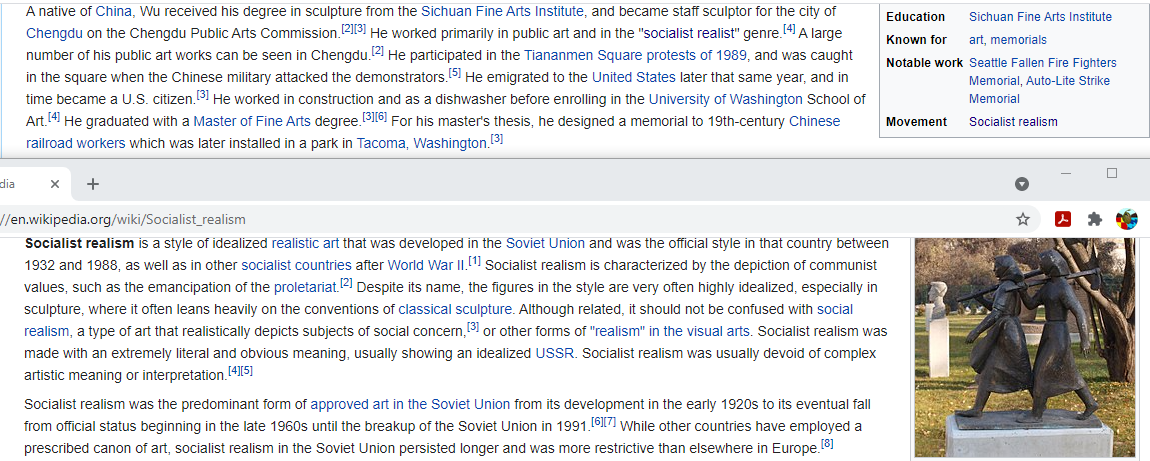Click link above to go to new website VoteBromley.com
ORIGIN OF NORTHGLENN VETERAN MEMORIAL
Origin of Northglenns Veteran Memorial. as found online via a wiki.
A native of China, Wu received his degree in sculpture from the Sichuan Fine Arts Institute, and became staff sculptor for the city of Chengdu on the Chengdu Public Arts Commission.[2][3] He worked primarily in public art and in the "socialist realist" genre.[4] A large number of his public art works can be seen in Chengdu.[2] He participated in the Tiananmen Square protests of 1989, and was caught in the square when the Chinese military attacked the demonstrators.[5] He emigrated to the United States later that same year, and in time became a U.S. citizen.[3] He worked in construction and as a dishwasher before enrolling in the University of Washington School of Art.[4] He graduated with a Master of Fine Arts degree.[3][6] For his master's thesis, he designed a memorial to 19th-century Chinese railroad workers which was later installed in a park in Tacoma, Washington.[3]
As of 2007, he divided his time between his home in Everett, Washington, and China.[7]
Wu is best known for sculpting the Seattle Fallen Fire Fighters Memorial in Seattle's Pioneer Square.[8] A design competition was held among all interested students in the UW School of Arts, and Wu's design was chosen.[3] He has erected similar memorials throughout the Pacific Northwest. He also created the Auto-Lite Strike Memorial in Toledo, which commemorates the violent United Auto Workers strike of 1934.[9] His work for Compass Health in Everett, Washington, was his first sculpture to focus on children.[10]
Socialist realism is a style of idealized realistic art that was developed in the Soviet Union and was the official style in that country between 1932 and 1988, as well as in other socialist countries after World War II.[1] Socialist realism is characterized by the depiction of communist values, such as the emancipation of the proletariat.[2] Despite its name, the figures in the style are very often highly idealized, especially in sculpture, where it often leans heavily on the conventions of classical sculpture. Although related, it should not be confused with social realism, a type of art that realistically depicts subjects of social concern,[3] or other forms of "realism" in the visual arts. Socialist realism was made with an extremely literal and obvious meaning, usually showing an idealized USSR. Socialist realism was usually devoid of complex artistic meaning or interpretation.[4][5]
Socialist realism was the predominant form of approved art in the Soviet Union from its development in the early 1920s to its eventual fall from official status beginning in the late 1960s until the breakup of the Soviet Union in 1991.[6][7] While other countries have employed a prescribed canon of art, socialist realism in the Soviet Union persisted longer and was more restrictive than elsewhere in Europe.[8]
https://en.wikipedia.org/wiki/Hai_Ying_Wu
https://en.wikipedia.org/wiki/Socialist_realism

YOUR TITLE
A native of China, Wu received his degree in sculpture from the Sichuan Fine Arts Institute, and became staff sculptor for the city of Chengdu on the Chengdu Public Arts Commission.[2][3] He worked primarily in public art and in the "socialist realist" genre.[4] A large number of his public art works can be seen in Chengdu.[2] He participated in the Tiananmen Square protests of 1989, and was caught in the square when the Chinese military attacked the demonstrators.[5] He emigrated to the United States later that same year, and in time became a U.S. citizen.[3] He worked in construction and as a dishwasher before enrolling in the University of Washington School of Art.[4] He graduated with a Master of Fine Arts degree.[3][6] For his master's thesis, he designed a memorial to 19th-century Chinese railroad workers which was later installed in a park in Tacoma, Washington.[3]
As of 2007, he divided his time between his home in Everett, Washington, and China.[7]
Wu is best known for sculpting the Seattle Fallen Fire Fighters Memorial in Seattle's Pioneer Square.[8] A design competition was held among all interested students in the UW School of Arts, and Wu's design was chosen.[3] He has erected similar memorials throughout the Pacific Northwest. He also created the Auto-Lite Strike Memorial in Toledo, which commemorates the violent United Auto Workers strike of 1934.[9] His work for Compass Health in Everett, Washington, was his first sculpture to focus on children.[10]